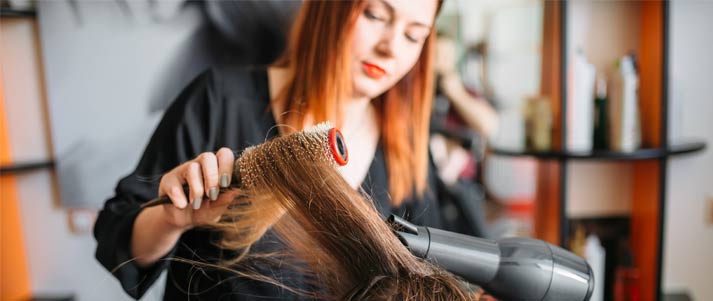How to make money selling your hair
Fancy making some extra cash from your fabulous head of hair? We've got the tips you need to read before you let anyone near you with those scissors.

Credit: Didecs (background), sanneberg (woman), NotionPic (purse) – Shutterstock
If you're short of a bob or two, a pair of scissors is all that stands between you and a couple of hundred quid – right?
Selling your hair isn't exactly a quick way to make cash (unless you've already got a head of healthy locks ready for snipping). But, there's some easy money to be made if you're planning on growing it anyway.
Here's what you need to know to get ahead of the hair market.
What's in this guide?
What you need to know about selling your hair
This is what you need to know if you want to sell your hair:
-
Human hair is in demand
Whether it's for weaves, wigs or extensions, human hair is in demand – and it's not just about fashion, either. People can lose their own for all kinds of reasons, from ageing to illness or just the luck of the draw.
Human hair is preferred for wigs and extensions instead of synthetic for the same reasons it looks good growing out of your head: it looks natural and it's easy to wash, colour or style.
Human hair has also been used in a whole variety of neat and nightmarish ways – for mopping up oil spills, for example. Whatever the reason, there are lots of places to sell your locks.
-
It's what's on the top of your head that counts
Just in case you're wondering – wig makers want the hair from your head. There are places to sell 'other' types of hair, but we'll let you sniff those out for yourself...
The good news is that hair harvesting isn't just for girls – there's no reason why guys can't get in on the act, too.
If that sounds wonderfully egalitarian, bear in mind that demand for hair from different ethnic groups varies massively around the world, with one UK hair handler stating they pay less for Asian hair than Caucasian.
-
Grow it long and to an even length

You might have seen adverts offering up to £200 for your greasy locks, but if that sounds like a shortcut to easy money... it's not.
Read the small print and you'll find payment typically starts at around £3 per ounce of hair. That's roughly equivalent to starting with shoulder-length hair and cutting all but a few inches off – and you'll earn less than the price of the average haircut.
The weight of your hair also makes a difference, with fabulous, full locks being in more demand than finer types.
Avoid getting your hair layered, too. Most buyers want hair that's the same length all the way around, but it is worth getting a cheap trim once in a while to keep the split ends away.
-
You need to plan ahead and keep it healthy
So, the money's not great – unless you plan in advance. And, given hair grows just six inches a year (if you're lucky), we could be talking serious preparation.
For starters, the big money is in long hair. Depending on who you sell it to, you'll need at least 16 inches of even hair (it won't work if you have layers) to make between £50 and £150.
Note the range, too – how much you actually get depends on how the buyer assesses the condition of your hair.
Wash your hair with a shampoo that doesn't contain sulfates, as this tends to dry hair out. Washing your hair every day will also cause the same problem, as you'll strip it of its natural oils. If you can, try washing it just twice a week to keep it shiny and strong.
-
Don't use heat on your hair to style it
To stand a decent chance of selling your hair, it's got to be in excellent, natural condition: not coloured, lightened, chemically treated or damaged in any way (including sun damage).
Untreated hair (or "virgin hair" as it's known on the market) sells for much more than any that's been coloured, permanently straightened or permed.
While this doesn't mean you can't have done those things in the past, it does mean you'll have to grow your hair out and lop off those bits before you can concentrate on harvesting the good stuff. Yeah, this really is a long game.
-
Find a buyer before you cut it off
You could end up kicking yourself if you don't follow the rules before you grab the shears. Luckily, there are only a few to keep in mind:
- Some companies won't accept anything other than freshly chopped hair, so don't hack it off until you find a buyer.
- Hair needs to be tightly secured, usually in a ponytail, before you cut it off. Some buyers also say it must be a ponytail and not a braid, but check with them first.
- You don't need to visit a hairdresser to get your hair cut, but make sure you know what's expected before having a go yourself.
-
Getting a haircut can be traumatic

We've all had one of those snips that have left us reaching for a hat – but if you think that's bad, going from Rapunzel to Phil Mitchell overnight is going to be even harder.
It doesn't matter how long you've been prepping for it, making the leap from long hair to barely there is going to feel pretty strange.
-
Package up your hair correctly
Make sure you pack up your hair following the instructions given to you by your buyer. These might have been outlined in your contract, so you'll want to give it a read before wrapping up.
If none were given, put your hair (still in the hair bobble) in a sandwich bag or clean container and then place it in a tightly sealed envelope. Remember to send it off with a tracking code so you and your buyer can follow your package.
Don't forget there are other ways to monetise your mane, including being a cut-and-colour guinea pig (ask your hairdresser), running a beauty blog or hair demos, or being a hair model.
And if you're creatively minded and not easily creeped out, you can even make and sell your own unique paint brushes, art or jewellery on Etsy.
Where to sell your hair
Here are the best places to sell your hair:
- There are a couple of well-known hair-buying sites, so it's worth seeing what they offer or advise before committing to anyone in particular. A couple of examples are Bloomsbury and Banbury Postiche.
- Try looking for wig makers or hair colleges in your area, or ask your hairdresser for leads.
- It's harder to find other industries that will take your barnet off your hands, but they are out there: false lashes, industrial gardening kits and fertilisers all use hair.
- You can try selling directly yourself: there's plenty of action on eBay and Gumtree. Make sure to include lots of details and photos about your hair's length and condition, and use keywords such as 'afro' or 'straight' as applicable.
- If you're in it for the long haul, set up a YouTube channel or another social media channel dedicated to your hair's progress so buyers have plenty of time to find you (and, who knows, maybe even start a bidding war). While you're there, see if you can activate your account for advertising and earn a little extra on the side.
Top tips for growing sellable hair
These are the best ways to maximise the amount of money you make from selling your hair:
- Know what you're aiming for and what's involved. If you're after 15 inches of shiny hair, you're going to have to commit!
- Ditch the hairdryer and straighteners, and keep your head away from extreme heat. Use products (hairspray, wax or whatever) sparingly, wash out thoroughly when they've done the job, and then towel-dry your hair gently.
- Deep condition your hair once a week with coconut oil overnight (but protect your PJs and pillows first!), or use one of these homemade hair treats.
- Wear a hat or use a heat protection spray in the sun, and think twice about swimming or surfing without a cap (you can forget about trying to lighten your hair with lemon juice, too!).
- Try to avoid brushing your hair too much or too enthusiastically – you could end up breaking it.
- Get healthy from the inside. Drink plenty of water, eat fruit and veg and get enough sleep. It will also help if you don't smoke.
Donate your hair to charity

Credit: Jpeg Photographer – Shutterstock
You could also donate your hair to charity if you're okay with not earning money from it. Apparently, even the likes of Kate Middleton and Harry Styles have donated their locks.
Certain charities collect human hair to make into wigs for people undergoing chemotherapy. They are given away free of charge, since wigs made out of real human hair are expensive.
For example, the Little Princess Trust provides wigs for people under the age of 24 who have lost their hair due to cancer treatment or other conditions.
The donated hair still has to meet certain requirements, which are usually very similar to those of regular buyers, so double-check whether your hair meets the standards before getting it cut off.
Looking for more ideas? We've compiled a list of unusual ways students make money.








